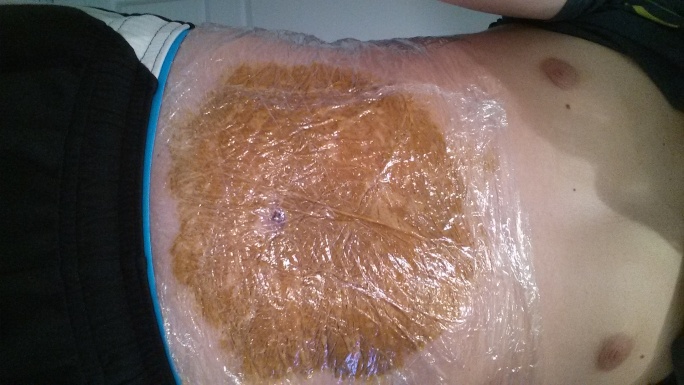Since everyone is stuck home due to the COVID-19 outbreak, I figured the time has come for me to share this important piece of information. Over the last few years, scientific evidence has accumulated that suggests that peanut butter can be effective in spot reduction. Or in other words; you can spread peanut butter over the parts of your body where you want to lose some fat.
While spot reduction has often been labeled a myth, it simply isn't. In 1983, a milestone paper named Drug delivery to local subcutaneous structures following topical administration was published in the Journal of pharmaceutical sciences [1]. They showed it was possible to get certain substances in the subcutaneous tissue (where the fat is), without it (significantly) reaching the bloodstream. At the time, this was a true game changer. This paves the way for products that can stimulate lipolysis (mobilization of free fatty acids from adipose tissue) in a targeted manner. You'd be able to rub something on the part of the skin where you want to lose fat. Rubbing it on your belly = losing fat on your belly.
I'll first discuss some of the science backing this up. But if you want to go straight to the practical stuff, scroll down further.
The science backing it up
This sounds nice and all, but is there actual science behind this? Yes there is.
In the same paper they describe this is possible with molecules with so-called amphiphilic properties. That means they have water-soluble as well as lipid-soluble properties. Later, a transport system based on these findings was described by Marcel Nimni. This system is also known as the 'trans-phase delivery system' (TPDS). It's based on the properties of benzyl alcohol, that can form amphilic micelles (particles), and thereby can function as a transporter for other molecules. In 1998 this concept was put to the test with a non-steroidal anti-inflammatory drug (NSAID) in rats. And with success [2]. Besides benzyl alcohol, isopropanol and acetone were also used. These two substances make the skin more permeable, further enhancing the ability of benzyl alcohol to penetrate the skin and stay at its target site.
Okay, getting stuff through your skin is one thing. But have they gotten anything lipolytic passing through the skin to succesfully spot reduce? Many attempts have been made, but without much luck. The solutions were either extremely expensive, not allowed by current laws, or most often: they simply didn't work...
But guess what? The ultimate product for this already exist. It works, is efficient, and widely available at any supermarket. Actually, no one should have a fat belly since 1893, the year spreadable peanut butter was invented. What's so special about it? Peanut butter naturally contains amphiphilic molecules which contain specific fatty acids that stimulate lipolysis [3]. It activates the enzyme hormone-sensitive lipase (HSL) in adipocytes (fat cells), which mobilizes the fatty acids from it [4]. The mechanism for this is unknown, but they suspect it's the result of the formation of cyclic AMP (cAMP). Additionally, these specific fatty acids in peanut butter also activate protein kinase A (PKA). This, in turn, inhibits adipogenic (fat-promoting) factors. Peanut butter also affects gen expression by binding to nuclear receptors that belong to the peroxisome proliferator-activated receptor (PPAR) family [5]. Normally, the fatty acids in peanut butter would be expected to promote storage of fat as triglycerides in adipose tissue, because of activation of PPARɣ. However, peanut butter is a weird one. It binds the receptor, but doesn't activate it. Thereby it blocks the receptor, so other fatty acids cannot bind and activate it. Practically speaking, it completely blocks adipocytes from storing fat.
In summary, peanut butter applied to the skin will lead to mobilization of fatty acids in the subcuteanous tissue underneath. This will lead to spot reduction, as the fat will be relocated in the body. You're thereby in control of where you store your body fat, using peanut butter.
Does it work in practice? Yes.
This knowledge is not new. But scientific evidence was lacking. On the Dutch bodybuilding forum bodybuilding.nl, the practice of applying peanut butter to the belly - a problem zone in most - has been adviced for many years.
Some examples:
- http://forum.bodybuilding.nl/topics/sixpack.369065/#post-8589830
- http://forum.bodybuilding.nl/topics/anabolenkuur.393664/#post-9385986
- http://forum.bodybuilding.nl/topics/beste-fatburner.394114/#post-9399124
Below a picture of a young man from the bodybuilding forum who has succesfully applied this method. It perfectly shows how you should apply the peanut butter in a comfortable manner. You spread it all over your belly (if that's where you desire to lose fat), and wrap it up in foil (or toilet paper!). Be sure to use a somewhat thick layer, so it completely covers the skin. The foil keeps it warm and moist, enhancing its effect. Additionally, it won't get your clothes stained and it helps with keeping the smell down. Your colleagues won't notice a thing! Except for your belly getting leaner by the day.

Results are to be expected within several days. Personally I advice a layer of atleast half a centimeter thick (or 0.2 inch). It should stay on the spot for atleast 12 hours a day. A Dutch brand I'd recommend is Calvé, but I think any brand would work well. Good luck!
References
- Guy, Richard H., and Howard I. Maibach. “Drug delivery to local subcutaneous structures following topical administration.” Journal of pharmaceutical sciences 72.12 (1983): 1375-1380.
- Mikulak, Stephen A., C. Thomas Vangsness, and Marcel E. Nimni. “Transdermal delivery and accumulation of indomethacin in subcutaneous tissues in rats.” Journal of pharmacy and pharmacology 50.2 (1998): 153-158.
- Van Peanut, Peter. “Fatty acids in peanut butter stimulate lipolysis in man.” Journal of Peanut Butter and Jelly 10.1 (2019): 1337-1344.
- Clifford, Gary M., et al. “Translocation of hormone-sensitive lipase and perilipin upon lipolytic stimulation of rat adipocytes.” Journal of Biological Chemistry 275.7 (2000): 5011-5015.
- Beanutputter John. “Novel mechanisms of fatty acids extracted from peanut butter: is PPAR involved?” Journal of Peanut Butter and Jelly 11.1 (2020): 114-802.
